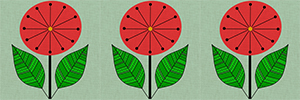It would be fair to say that most any type of design work eventually ends up being a digital design. Even artists can only have one original painting or drawing. Additional copies are then copied or digitized before printing. However, the true definition of digital design is a design that is created for an actual digital format like a website, app, or social media. Whereas print design is created for a physical product. But, sometimes the two will overlap. You may create a logo design for a website that also needs to be used in printing paper products. For the most part though, you can think of digital design as being on a screen and print design on anything you can physically touch. Many designers do work with both interchangeably.
Besides the different outputs of digital design vs. print design, there are also differences in the creation process that are important to know. The resolution, colors, and typography used in digital design will be quite different than what is needed for print design.
Resolution And Differences In DPI/PPI

One of the biggest differences between designing for the web and print design is the size of the file or resolution used. DPI stands for dots per inch and is used in print design. PPI is similar but stands for pixels per inch and is used in web design. On the web, a low PPI of 72 is all that is needed to get a good clear picture on screen. So, when designing a website banner, the image created at 72 DPI will load faster than one that is larger. However, with print, you need a much higher resolution for printing at large sizes. The standard DPI for print is 300 but you can sometimes get away with 150 depending on the size of what you are printing. More dots per inch creates a sharper image.
In Photoshop, pixels/inch is used when setting resolution regardless of whether for print or web. From the drop down menu next to resolution, select pixels/inch and then key in 72 for web or 300 for print.
How Color Is Displayed

When designing, it’s also important to think about how color is displayed. Online screen displays use RGB color (red, green, blue) whereas printers work with CYMK (cyan, magenta, yellow, and black). For accurate color display, make sure to set the color mode at the point of creating a new canvas in Photoshop.
Typography Matters
In print design, you can go crazy with typography (to a point!). A good designer knows what fonts pair well together as to not overwhelm. However, with web design, it’s best to stick with font styles that are simple, easy to read, and clear. It’s usually best to stick with Google fonts that work on most browsers. Fonts that aren’t compatible with certain browsers or computers will be substituted with a common font style that you may not like or choose on your own.
Types Of Digital Design
Website Design
Before beginning the actual visual design of the website, a designer needs to figure out the flow and usability that the site needs to have. This is done by creating flow charts and wire frames. Once the basic flow or layout is determined, the design is created.
Key factors in web design include whitespace, balance, color, and typography. Website designers typically use software like Photoshop to design the look of a website. However, a designer will work in tandem with a developer to actually make the design work and be interactive. Sometimes the designer and developer are the same person. Once the static design or mock-up is created, the developer will use coding to create the same look that was designed. For instance, the designer creates the look of the navigation bar. Background color, font style, location, and size are all jobs of the designer. Then, the developer takes that design and makes it functional so that the navigation labels link to the proper areas on the site.
App Design
App or mobile design is much like the web design process. The main difference being screen size. Because of having a smaller footprint on screen, apps will have a more minimal design. Hamburg menus will replace large navigation bars, images will be kept to a minimum, and blocks of text will be shorter.
Branding – Logos and Banners
Logos and banners are static assets that are used in the layout of a web page. There are typically suggested sizes to design these based on the platform where the designs will be used. Any logos or banners that will also be used in print design should be created at a higher resolution. The images can then be condensed to use on the web for faster load times.
Infographics
Infographics are charts that use mainly icons and images to outline a procedure or communicate other information quickly and easily. These static designs are a great addition to a website page and work well for an image to pin on Pinterest or other social media to draw interest to a site.
Email Design
Email designs target the subscribers to your website. A good email design will be attention grabbing and draw subscribers back to your site.
Types Of Print Design
Home And Personal Accessories
Any item that you can touch that has the ability for a unqiue design. Some of the most popular products are t-shirts, mugs, pillows, or phone cases. Each product will have it’s own size template to create a design for.
Brochures, Letterheads, Ads
Anything printed on paper products. Again, designing for common template sizes will ensure that a design works well. For instance, a greeting card will have a front, inside left, inside right, and back that all need to be considered.
Fabric
Most fabric designs are designed with a seamless repeat pattern.


